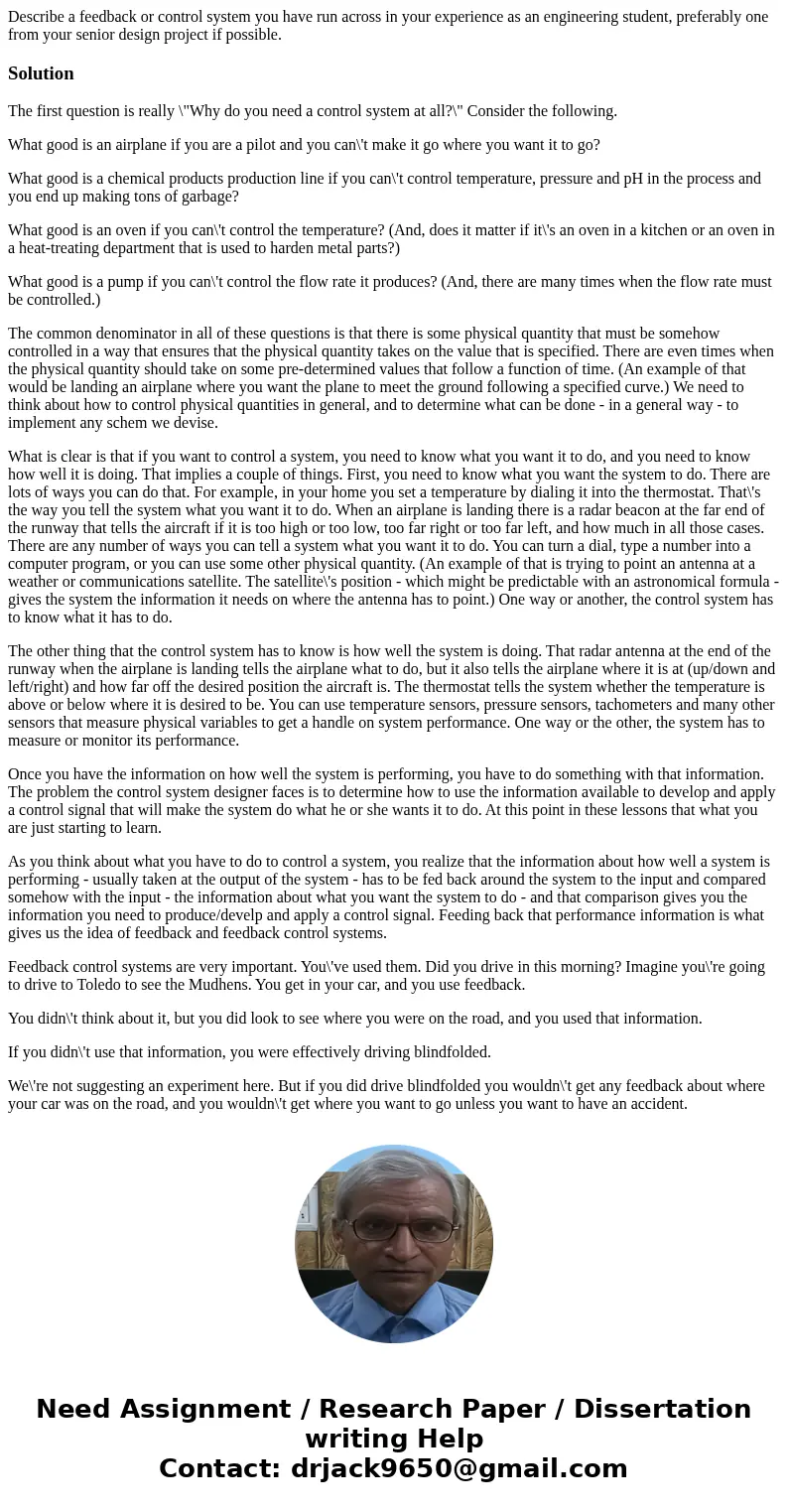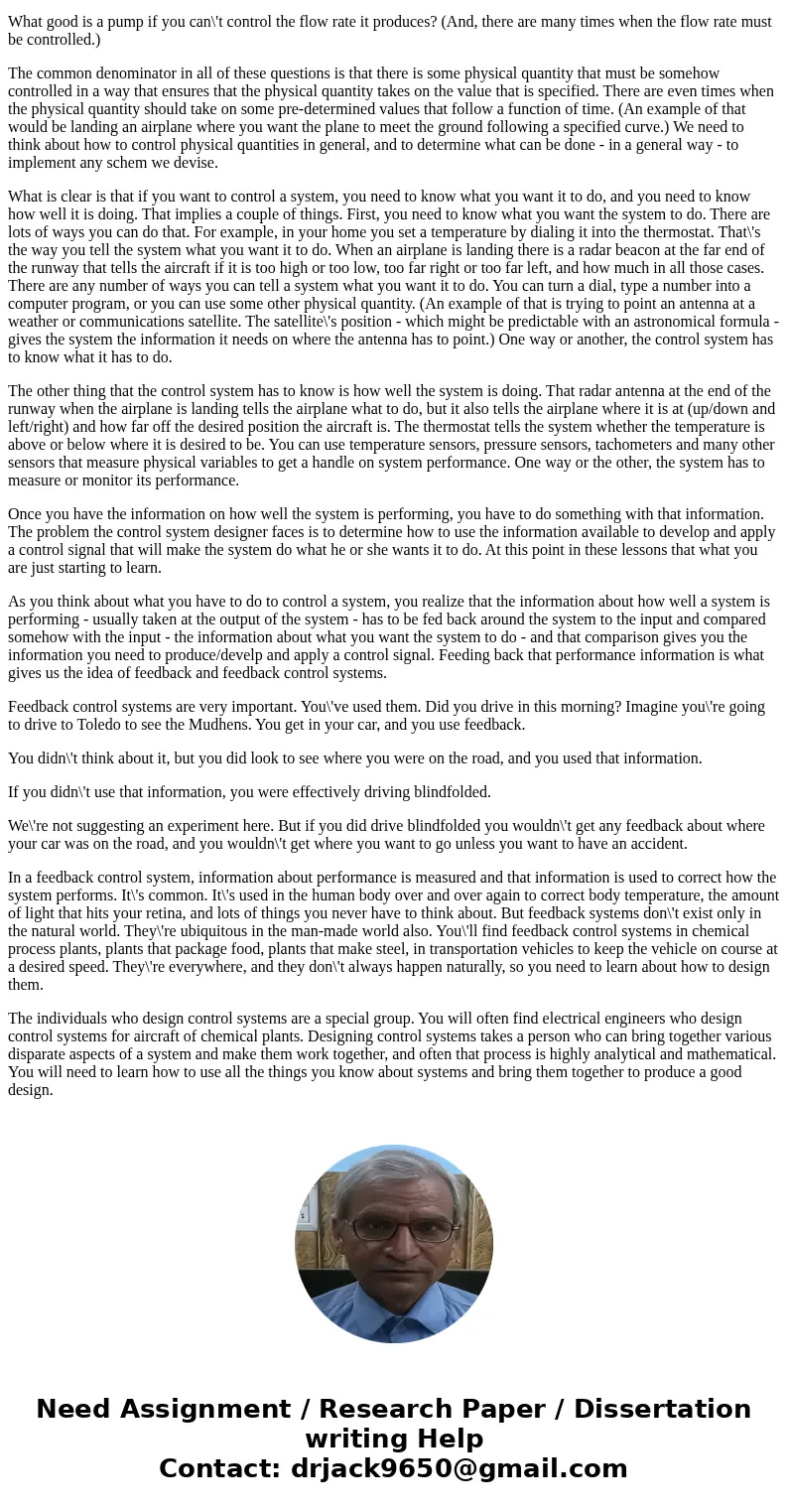Describe a feedback or control system you have run across in
Solution
The first question is really \"Why do you need a control system at all?\" Consider the following.
What good is an airplane if you are a pilot and you can\'t make it go where you want it to go?
What good is a chemical products production line if you can\'t control temperature, pressure and pH in the process and you end up making tons of garbage?
What good is an oven if you can\'t control the temperature? (And, does it matter if it\'s an oven in a kitchen or an oven in a heat-treating department that is used to harden metal parts?)
What good is a pump if you can\'t control the flow rate it produces? (And, there are many times when the flow rate must be controlled.)
The common denominator in all of these questions is that there is some physical quantity that must be somehow controlled in a way that ensures that the physical quantity takes on the value that is specified. There are even times when the physical quantity should take on some pre-determined values that follow a function of time. (An example of that would be landing an airplane where you want the plane to meet the ground following a specified curve.) We need to think about how to control physical quantities in general, and to determine what can be done - in a general way - to implement any schem we devise.
What is clear is that if you want to control a system, you need to know what you want it to do, and you need to know how well it is doing. That implies a couple of things. First, you need to know what you want the system to do. There are lots of ways you can do that. For example, in your home you set a temperature by dialing it into the thermostat. That\'s the way you tell the system what you want it to do. When an airplane is landing there is a radar beacon at the far end of the runway that tells the aircraft if it is too high or too low, too far right or too far left, and how much in all those cases. There are any number of ways you can tell a system what you want it to do. You can turn a dial, type a number into a computer program, or you can use some other physical quantity. (An example of that is trying to point an antenna at a weather or communications satellite. The satellite\'s position - which might be predictable with an astronomical formula - gives the system the information it needs on where the antenna has to point.) One way or another, the control system has to know what it has to do.
The other thing that the control system has to know is how well the system is doing. That radar antenna at the end of the runway when the airplane is landing tells the airplane what to do, but it also tells the airplane where it is at (up/down and left/right) and how far off the desired position the aircraft is. The thermostat tells the system whether the temperature is above or below where it is desired to be. You can use temperature sensors, pressure sensors, tachometers and many other sensors that measure physical variables to get a handle on system performance. One way or the other, the system has to measure or monitor its performance.
Once you have the information on how well the system is performing, you have to do something with that information. The problem the control system designer faces is to determine how to use the information available to develop and apply a control signal that will make the system do what he or she wants it to do. At this point in these lessons that what you are just starting to learn.
As you think about what you have to do to control a system, you realize that the information about how well a system is performing - usually taken at the output of the system - has to be fed back around the system to the input and compared somehow with the input - the information about what you want the system to do - and that comparison gives you the information you need to produce/develp and apply a control signal. Feeding back that performance information is what gives us the idea of feedback and feedback control systems.
Feedback control systems are very important. You\'ve used them. Did you drive in this morning? Imagine you\'re going to drive to Toledo to see the Mudhens. You get in your car, and you use feedback.
You didn\'t think about it, but you did look to see where you were on the road, and you used that information.
If you didn\'t use that information, you were effectively driving blindfolded.
We\'re not suggesting an experiment here. But if you did drive blindfolded you wouldn\'t get any feedback about where your car was on the road, and you wouldn\'t get where you want to go unless you want to have an accident.
In a feedback control system, information about performance is measured and that information is used to correct how the system performs. It\'s common. It\'s used in the human body over and over again to correct body temperature, the amount of light that hits your retina, and lots of things you never have to think about. But feedback systems don\'t exist only in the natural world. They\'re ubiquitous in the man-made world also. You\'ll find feedback control systems in chemical process plants, plants that package food, plants that make steel, in transportation vehicles to keep the vehicle on course at a desired speed. They\'re everywhere, and they don\'t always happen naturally, so you need to learn about how to design them.
The individuals who design control systems are a special group. You will often find electrical engineers who design control systems for aircraft of chemical plants. Designing control systems takes a person who can bring together various disparate aspects of a system and make them work together, and often that process is highly analytical and mathematical. You will need to learn how to use all the things you know about systems and bring them together to produce a good design.


 Homework Sourse
Homework Sourse